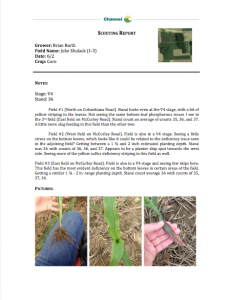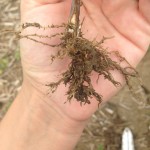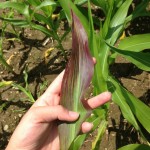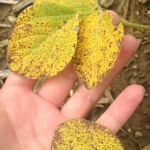Now that the corn and soybean fields have come up and the stands are well on their way, it’s prime time to be scouting the fields for early season disease, damage, and nutrient deficiency. These days are almost always spent by myself on a particular grower, driving around to about a dozen fields walking the crop, taking measurements, and recording observations with notes and pictures. Scouting for the top ten growers in my area has been assigned to me by my DSM as my regional project, one of the three projects that must be done in order to successfully complete my internship. This project had to provide a benefit to the sales region, and this gives my DSM and the Channel brand more communication touch-points throughout the season with the grower (we aim for about four main in-field connections from planting to harvest).
Now something that I have noticed about my experience with seed dealers in the Midwest versus seed dealers in the Northeast is that often, salesmen are only really there when the sale is being made and when the results are being calculated. At home in Iowa, our farm is used to having seed dealers and salesmen checking in with us at all stages of the growth process to ensure that we are satisfied with the product so far. This is uncommon for this area I am working in, and Channel is bringing that element into seed sales in this region of the US, as it was designed primarily to bring Monsanto-quality genetics with a higher level of personal service.
I collect my maps for the day and plan a route before I leave, mostly to save time and limit my driving distance so I don’t have to backtrack in a particular area. With my tools such as a seed pick, pocket field guide, spade, measuring tape, and a pretty strong agronomy background, I’m off to check up on the crops. The first field of the day is soybeans, which seems to be the popular crop this year. I walk out into the field a ways and start by looking over the leaves for foliar damage or feeding. Next, I dig up the plant to observe the roots. All too often, this part is overlooked and it is important to the overall level of plant health. I see some small nodules starting to form, but a few signs of root limiting with the soil compaction as a result of a no-till system. I notice some leaf discoloration in the wetter areas of the field, which could be the result of numerous things. I have an idea of what disease it could be, but just to be sure I refer to my field guide. Eventually I find the page and my suspicions are confirmed: this grower has a little Brown Spot, which is not unusual for the cool, wet weather. I do a few quick stand counts, noting that the population looks good, and finish up the walkthrough while taking a few pictures.
In the cornfields, the procedure is fairly similar (it’s just harder to walk through, especially when the corn gets tall). Because of the early May frost this part of the country received, some of the corn was damaged after planting. If it didn’t corkscrew back into the ground after imbibing cold water as it germinated, the corn plant shows some signs of frost damage on the leaves, or a few didn’t even emerge. This was an issue with quite a few growers this year, but the reality is that you can’t control the weather. I see some cases of phosphorus deficient in a few fields and a lack of sulfur in others, all of which can be fixed by fertilizer applications. A few weeds are starting to sprout up in fields, so I make a note of what kinds I see and perhaps make a spray recommendation.
Taking more photos, I see that some of these fields have issues with compaction as well, and that the end rows are particularly behind in growth stage as compared to the majority of the field. Field signs aren’t up yet, and my DSM and I probably won’t place them until after the corn tassels, but I know what varieties are in which fields with my maps, and it’s easy to see which ones are performing better. I make a mental note to report my observations on this to my DSM – he’ll find it interesting. I pull a corn plant out (they’re still small enough where I don’t have to dig them) and look at the roots. No visible rootworm feeding, which is more of an issue where I am from rather than the NE. So far, so good: I’ll be sure to check back up on this grower’s fields in another few days.
With all of my pictures and notes, I head back to my apartment at the end of the day to type up my reports. This is very important, as the reports have all of my comments and pictures that I can share with my grower and DSM in a detailed format. I create the write-ups and have my DSM proofread them later in the evening through email before I send it out the farmer, just to make sure all of my information is accurate and consistent. In the morning, I get an email back from the farmer asking if he should put down some in-season nitrogen, to which I reply it may be a beneficial application. Being able to share information and make recommendations with my farmers has been a both a rewarding and challenging experience, pushing me to think critically and problem solve, as well as put my agricultural knowledge to the test.
Root development, phosphorous deficiency, and soybean brown spot.




